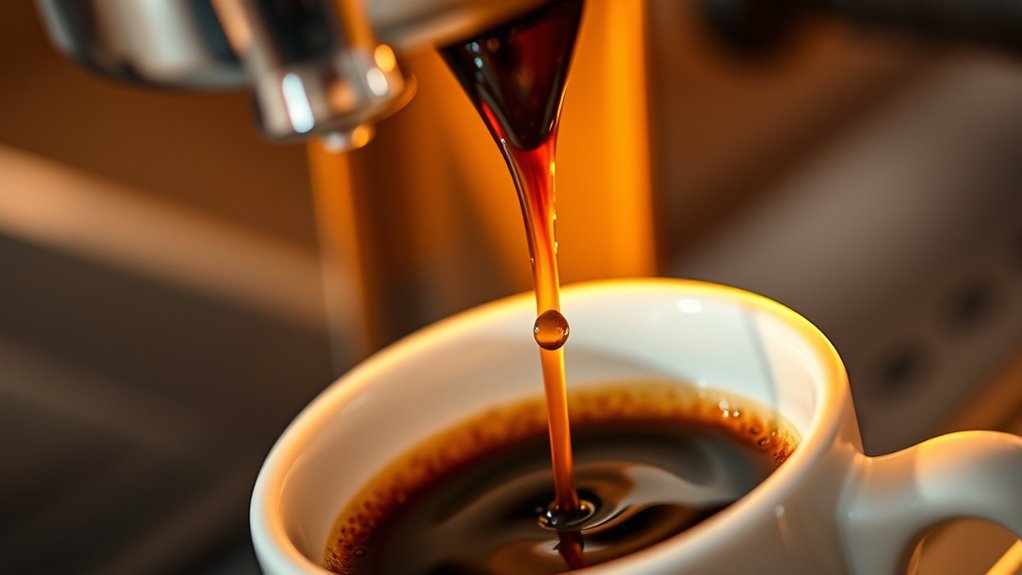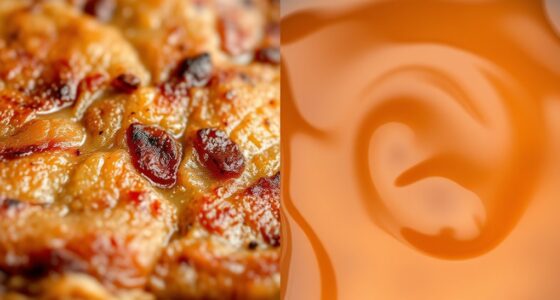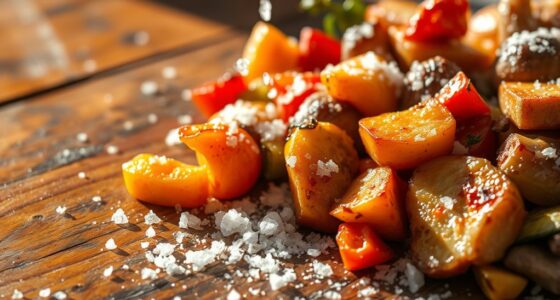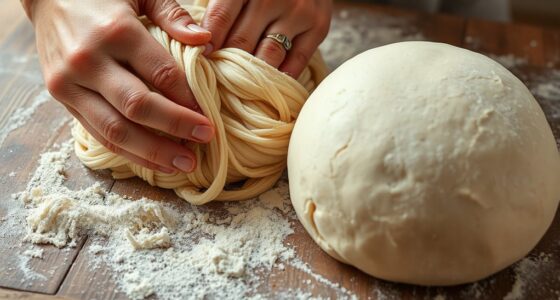In espresso extraction, pressure forces hot water through coffee grounds at around 9 bars, helping dissolve flavors and create crema. Temperature, kept between 195°F and 205°F, affects how quickly compounds dissolve, impacting flavor balance. Brew time, ideally 25–35 seconds, guarantees proper extraction—too short causes sourness, too long results in bitterness. Water flow dynamics, influenced by grind size and tamping, also play a vital role. To master these physics, keep exploring the details behind each factor.
Key Takeaways
- Proper pressure (~9 bars) ensures water flows evenly through coffee grounds, facilitating optimal extraction of flavors and oils.
- Temperature (195°F–205°F) increases solubility, controlling how quickly compounds like acids and sugars dissolve during extraction.
- Brew time (25–35 seconds) balances extraction, preventing under-extraction (sour) or over-extraction (bitter) flavors.
- Water flow dynamics, influenced by pore size and porosity, affect flow rate, uniformity, and flavor consistency.
- Precise control of pressure, temperature, and timing optimizes extraction efficiency and espresso quality.
The Fundamentals of Pressure in Espresso Extraction
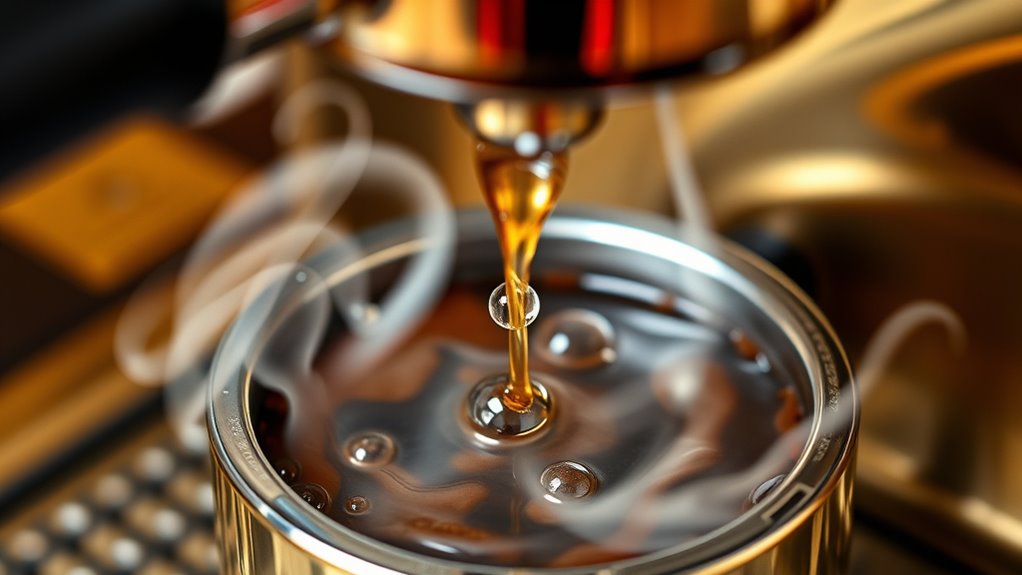
Pressure is a key factor in extracting the best flavors from espresso. When you use an espresso machine, it typically operates at around 9 bars of pressure to force hot water through the coffee grounds. This pressure ensures proper extraction, emulsifying oils and gases to produce the rich crema you seek. If pressure exceeds 9 bars, over-extraction can occur, leading to bitter flavors, while lower pressure risks under-extraction and weak taste. The machine’s pump maintains consistent pressure throughout the brew, which is essential for reproducible results. Proper pressure influences extraction time and flavor profile; fine-tuning it allows you to craft the perfect shot. Water temperature and brew time work alongside pressure to optimize flavor, but pressure remains fundamental in shaping your espresso’s character. Monitoring pressure stability during extraction is crucial to achieving consistent quality, and understanding how pressure affects extraction helps baristas refine their technique. As with other aspects of brewing, maintaining optimal pressure levels reflects the importance of balance and control in achieving the best results. Additionally, consistent pressure helps prevent channeling, which can lead to uneven extraction and compromised flavor.
How Temperature Influences Solubility and Flavor Development
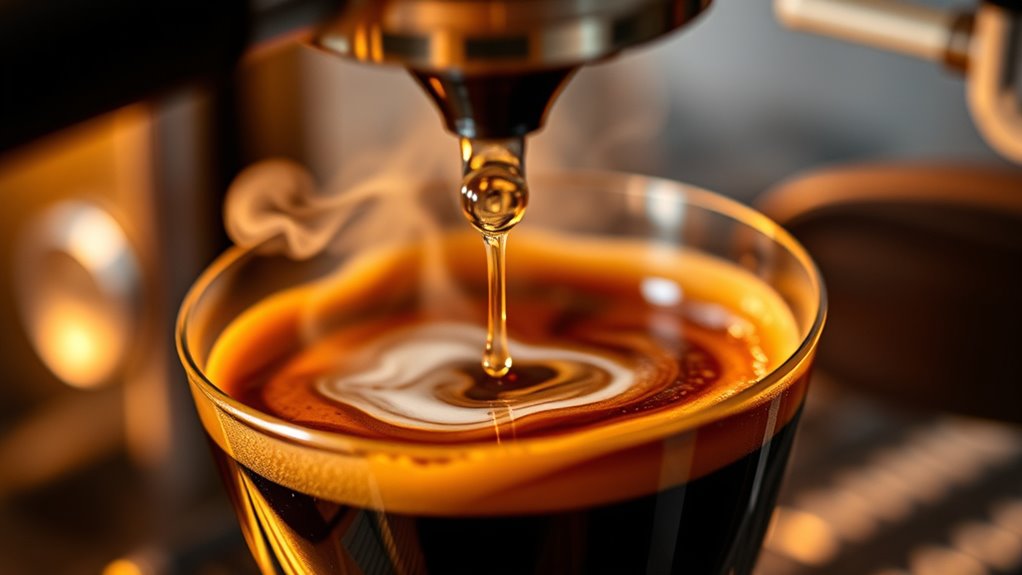
Temperature plays a crucial role in determining how coffee compounds dissolve during extraction. When you keep the temperature within the ideal range of 195°F to 205°F, solubility increases, enabling more flavors to be extracted efficiently. As temperature rises, acids, sugars, and oils dissolve faster, enriching the flavor development. Additionally, understanding brew temperature control helps baristas optimize extraction and flavor. However, if the temperature exceeds this range, it accelerates the extraction of bitter compounds, potentially leading to an over-extracted, harsh taste. Conversely, lower temperatures reduce solubility, resulting in a brighter, more acidic profile with fewer bitter notes. Maintaining precise temperature control helps keep solubility rates consistent, supporting balanced flavor development. Deviations from the perfect range can cause under- or over-extraction, negatively impacting the complexity and harmony of your espresso. Additionally, understanding how to foster a digital-friendly environment at home can enhance your overall coffee experience by integrating innovative brewing techniques and tools. Properly managing temperature also ensures the extraction process remains efficient, preserving the delicate balance of flavors desired in a well-crafted espresso.
The Role of Brew Time in Achieving Optimal Extraction
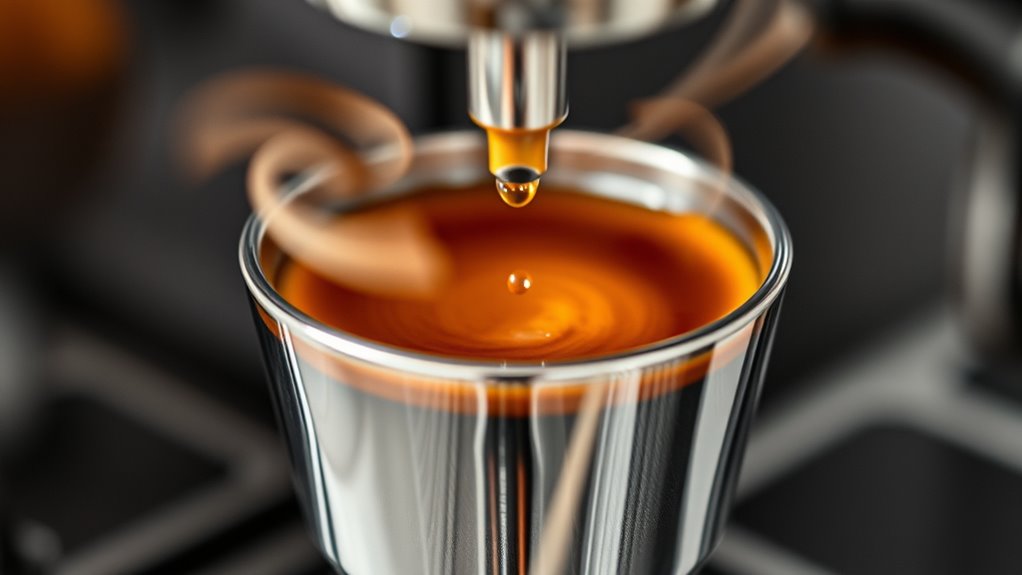
You need to carefully control your brew time to find the right extraction balance, ensuring your espresso develops full flavor without bitterness. If you pull shots too quickly, you’ll risk under-extraction, resulting in sour, weak coffee; too long, and over-extraction can make it harsh and bitter. Achieving the ideal timing helps clarify flavors and highlights desirable compounds like sugars and acids. Regularly monitoring your shot duration can help maintain consistent quality in your espresso. Brew time is a critical factor in achieving optimal extraction, and understanding the caffeine content can assist in managing your intake while enjoying your coffee. Additionally, precise control of pressure and temperature during extraction further enhances the flavor profile and overall quality of the espresso. Properly calibrating your equipment ensures that variables like pressure stability are maintained, leading to more consistent and flavorful shots, which ultimately depends on understanding the optimal machine calibration techniques.
Extraction Balance Dynamics
Brew time plays an essential role in balancing the extraction of flavor compounds in espresso. Too short or too long, and you’ll risk under- or over-extraction, disrupting the desired flavor profile. Shorter brew times under 20 seconds cause under-extraction, leaving sour, weak shots with incomplete solubility of sugars and oils. Conversely, longer brew times over 40 seconds lead to over-extraction, pulling bitter compounds and tannins that spoil the taste. Achieving the right extraction balance requires precise control over grind size, tamping, and flow rate. Here’s a quick overview:
| Brew Time | Extraction Focus | Flavor Impact |
|---|---|---|
| <20 sec | Under-extraction | Sour, weak, insufficient solubility |
| 25-35 sec | Ideal extraction | Balanced, rich, complex flavors |
| >40 sec | Over-extraction | Bitter, harsh, undesirable tannins |
Additionally, consistent grind size can significantly influence the quality of espresso extraction, ensuring optimal flavor and consistency in each shot.
Over- vs. Under-Extraction Effects
The duration of extraction directly influences the flavor quality of your espresso, with too short or too long brew times leading to undesirable results. If your extraction time is too brief, typically under 20 seconds, you risk under-extraction, resulting in sour, weak coffee with incomplete flavor development. Conversely, over-extraction occurs when brew time exceeds 40 seconds, causing bitter, harsh flavors as undesirable compounds are overly dissolved from the coffee grounds. Achieving the *ideal* extraction time—usually between 25 to 35 seconds—ensures that desirable solubles like sugars and acids are properly extracted, balancing flavor, aroma, and crema quality. Fine-tuning grind size, tamping pressure, and dose helps control brew time, preventing both over- and under-extraction for a richer, more satisfying espresso.
Timing for Flavor Clarity
Achieving peak flavor clarity in espresso hinges on precise brew timing, which directly influences how well desirable flavors are extracted. The extraction time, typically between 25 and 30 seconds, is vital for balancing flavor and avoiding under- or over-extraction. Shorter times under 20 seconds often lead to sour, weak espresso due to incomplete solubilization of acids, sugars, and oils. Longer brew times over 35 seconds tend to produce bitter, harsh flavors from excessive extraction of polyphenols. Controlling timing through grind size and tamping pressure ensures the brewing process efficiently dissolves the right compounds, highlighting sweet and aromatic notes. Consistent brew time is essential for repeatable flavor clarity, as it determines the rate at which desirable compounds are solubilized into your espresso. Additionally, maintaining the appropriate brew time helps preserve the integrity of the delicate balance of flavors characteristic of well-extracted espresso.
Fluid Dynamics and Water Flow Through Coffee Grounds
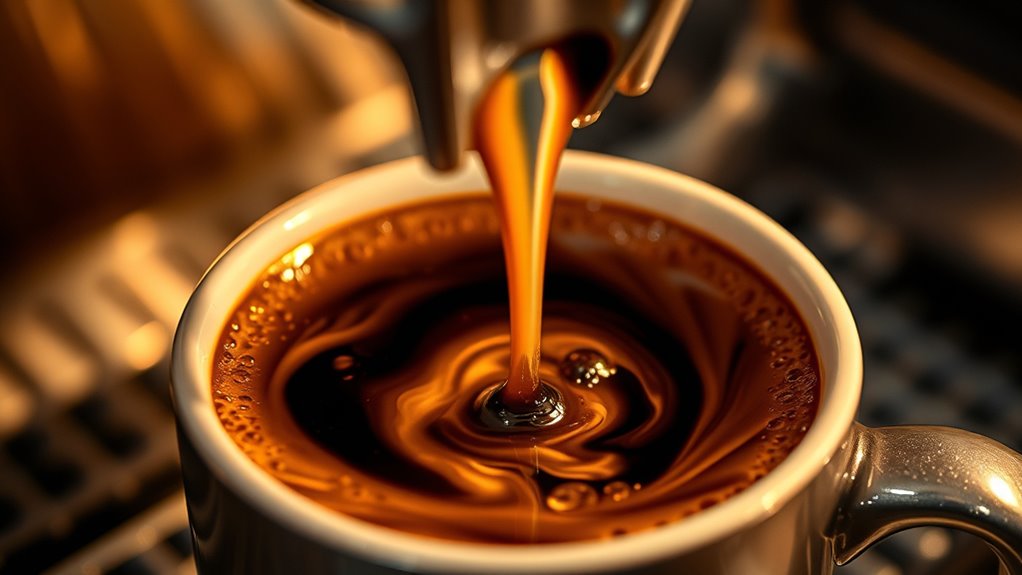
You see how hot water moves through coffee grounds under pressure, influenced by flow velocity and pressure differences. The porosity and density of the grounds control how easily water passes, shaping the extraction process. Turbulence affects flow uniformity, with too much causing channeling and uneven flavors. Additionally, the vetted quality of the coffee grounds ensures consistent extraction and flavor profile. The fluid dynamics involved in water flow can be further understood by examining how various factors such as temperature and pressure impact flow behavior. The water flow mechanisms are also similar to how water interacts within self watering plant pots, where controlled flow and reservoir levels influence overall plant health and growth. Understanding the water flow mechanisms helps optimize extraction efficiency and flavor consistency in espresso brewing.
Water Velocity and Pressure
Water velocity during espresso extraction is primarily driven by the pressure applied, commonly around 9 bars, which pushes water swiftly through the coffee grounds. This pressure creates a flow rate that depends on the pore size and resistance within the grounds. Higher pressure increases water velocity, resulting in faster extraction, while lower pressure slows the flow. The flow rate influences extraction time, with too high a velocity risking uneven extraction or channeling. The Hagen-Poiseuille equation explains how pressure difference and ground porosity determine flow through the coffee bed. Finer grounds increase resistance, lowering water velocity and extending extraction time. Conversely, coarser grounds allow faster flow. Maintaining ideal pressure and flow rate ensures consistent water velocity, resulting in a balanced and efficient espresso extraction. Hydrotherapy techniques, utilizing water flow, can also be applied for muscle relaxation and recovery after intense extraction sessions. Additionally, understanding automation in machinery can help optimize these parameters for consistent results.
Porosity and Ground Density
How does the porosity and density of coffee grounds influence water flow during extraction? Higher porosity from larger pore size allows faster water flow, reducing extraction time but risking uneven extraction. Denser grounds decrease porosity, slowing water and increasing resistance. Uniform ground density promotes consistent water distribution, while uneven packing causes channeling and inefficient extraction. Use the following table to understand these relationships:
| Property | Effect on Water Flow | Impact on Extraction Efficiency |
|---|---|---|
| Higher porosity | Faster water flow, larger pores | Potential for uneven extraction |
| Higher ground density | Slower water flow, increased resistance | More uniform extraction, better flavor |
| Pore size | Larger pores, quicker flow | Influences extraction completeness |
Turbulence and Flow Uniformity
The flow of water through coffee grounds is heavily influenced by fluid dynamics, which governs how pressure, viscosity, and pore structure interact during extraction. Turbulence within the puck promotes better mixing and more consistent extraction by disrupting laminar flow and reducing channeling. To optimize flow uniformity, consider these factors:
- Maintaining an appropriate pressure differential across the portafilter.
- Ensuring proper tamping to create a uniform pore structure.
- Designing flow channels that promote turbulence and even flow distribution.
- Monitoring the Reynolds number to predict flow regime and adjust parameters accordingly.
Balancing Pressure and Temperature for Consistent Results
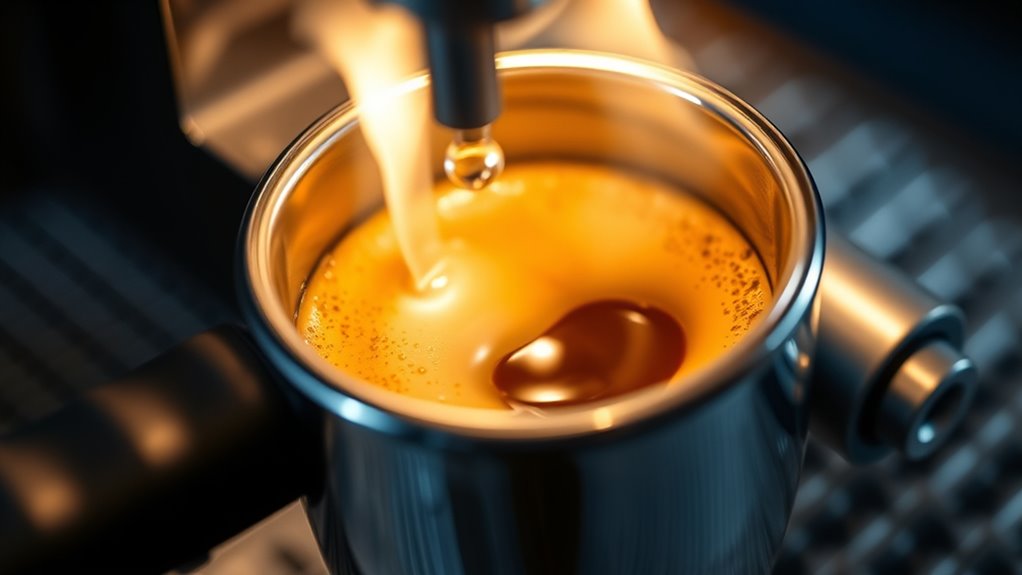
Achieving consistent espresso results depends on carefully balancing pressure and temperature, as fluctuations can markedly impact flavor and crema quality. Maintaining a stable temperature between 195°F and 205°F ensures proper extraction and prevents bitterness caused by overheating. Proper calibration of the machine’s settings minimizes variability from ambient conditions and equipment differences. Adjusting pressure around 9 bars optimizes water flow through the coffee grounds, balancing flavor extraction and crema formation. Modern espresso machines with PID controllers help regulate temperature precisely, reducing fluctuations that could alter extraction quality. When pressure and temperature are well-calibrated and stable, you prevent under- or over-extraction, ensuring each shot maintains its intended flavor profile. This level of control is crucial for consistent, high-quality espresso.
The Physics Behind Crema Formation and Texture
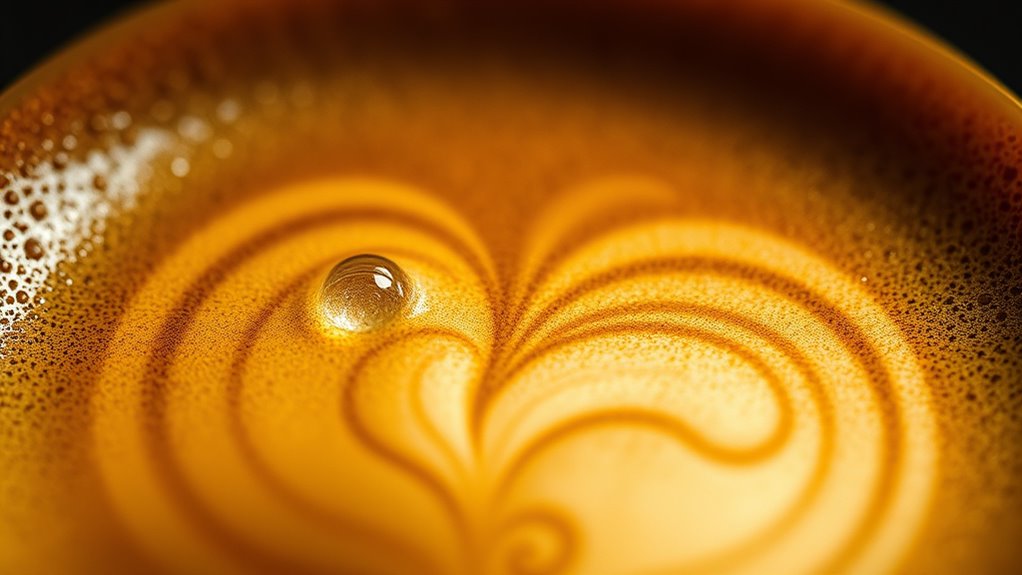
Crema forms through the interplay of pressure, temperature, and the chemical composition of the coffee, creating a stable foam on top of your espresso. When hot water under about 9 bars of pressure passes through the grounds, it forces gases like CO₂ into the oils, causing gas emulsification that stabilizes the crema. The temperature range of 195°F to 205°F ensures oils and gases dissolve properly, impacting the richness and stability of the foam. To optimize crema texture and appearance, consider these key factors:
Crema forms through pressure, temperature, and coffee chemistry, creating a stable foam that enhances espresso richness and appeal.
- Fineness of grind
- Freshness of beans
- Precise pressure
- Proper temperature during extraction
Together, these elements influence the velvety feel and visual appeal of your espresso’s crema.
Impact of Machine Design on Extraction Efficiency
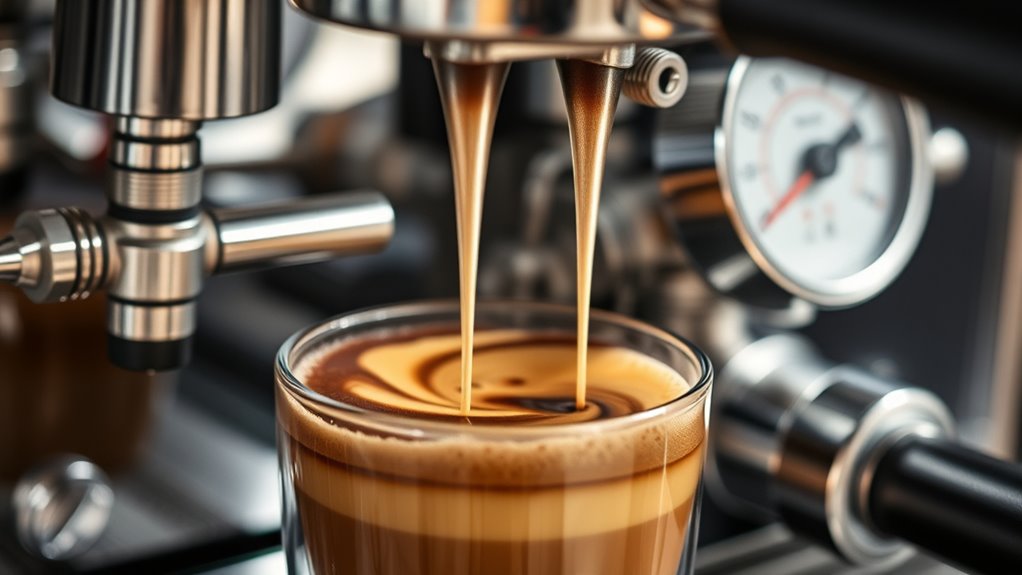
Machine design plays a pivotal role in how efficiently an espresso is extracted by influencing water flow, pressure stability, and temperature control. A well-designed boiler guarantees stable water temperature, maintaining flavor consistency. The type of pump affects pressure stability, with rotary pumps offering more responsiveness than vibratory ones, impacting shot quality. The flow path within the machine determines how uniformly pressure and temperature are delivered, directly affecting extraction efficiency. Features like PID temperature controllers help keep brew temperatures precise, reducing fluctuations caused by design limitations. Additionally, ergonomic portafilter and group head designs promote even water distribution and ideal contact with coffee grounds. Overall, thoughtful machine design enhances extraction efficiency by ensuring stable, consistent conditions throughout the brewing process.
Practical Techniques for Calibrating and Controlling Variables
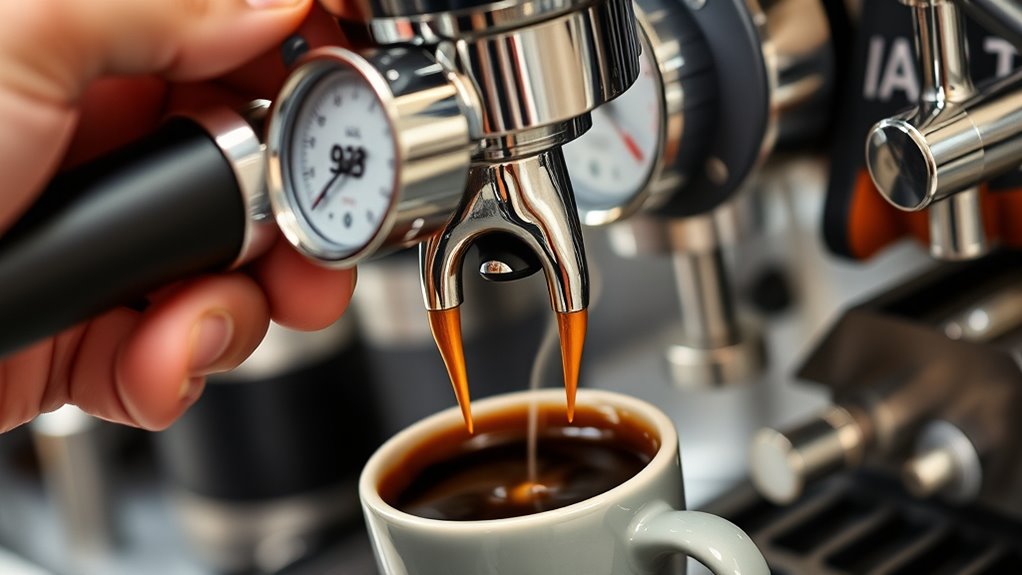
To optimize espresso extraction, you need to actively calibrate and control key variables like grind size, dose, temperature, and pressure. Proper calibration guarantees consistent results and flavor.
Consistent espresso quality depends on precise calibration of grind, dose, temperature, and pressure.
- Use a calibrated scale to measure around 18-20 grams for a double shot, keeping extraction variables stable.
- Adjust grind size with your burr grinder until brew time hits 25-30 seconds, preventing over- or under-extraction.
- Maintain temperature stability by calibrating your machine’s thermostat or PID controller, ensuring consistent heat.
- Use a pressure gauge or machine with pressure monitoring to dial in around 9 bars, balancing extraction efficiency and crema.
Routine calibration tests with test shots help you refine your grind size, tamping, and brew time based on visual cues and taste feedback, optimizing extraction variables.
Frequently Asked Questions
What Is the Science Behind Espresso Extraction?
You wonder about the science behind espresso extraction. When hot water passes through finely ground coffee under pressure, it dissolves oils, acids, and sugars, creating that rich flavor. The temperature, pressure, and extraction time influence which compounds dissolve, shaping the taste and aroma. Precise control guarantees the right balance of flavors, preventing under- or over-extraction, so your espresso develops its complex, desirable profile.
What Temperature and Pressure for Espresso?
Think of brewing espresso like a delicate dance—you need the right steps at the right time. To get that perfect shot, keep your machine’s temperature between 195°F and 205°F, ensuring your coffee’s flavor blossoms without bitterness. Maintain about 9 bars of pressure to push water through grounds smoothly. When you master this balance, each shot sings with richness, crema, and that irresistible aroma you crave.
How Does Temperature Affect Espresso Extraction?
You might wonder how temperature affects your espresso. When you use water within the ideal range of 195°F to 205°F, it helps extract flavors efficiently, balancing acids, sugars, and bitterness. If the temperature is too high, you risk over-extraction, making your espresso bitter. Too low, and you’ll get under-extraction, resulting in sour or flat taste. Maintaining consistent temperature guarantees your espresso’s flavor profile stays balanced and enjoyable.
How Long Should Espresso Extraction Time Be?
You should aim for an espresso extraction time between 25 and 35 seconds. If it’s shorter than 20 seconds, your shot may taste sour and weak because it’s under-extracted. If it goes beyond 40 seconds, it could become bitter and harsh from over-extraction. To hit that ideal window, adjust your grind size, tamping pressure, and brew volume, ensuring a balanced, flavorful shot every time.
Conclusion
Mastering espresso is like conducting a symphony where time, pressure, and temperature dance in harmony. When you fine-tune these variables, you reveal a world of rich, vibrant flavors that awaken your senses. Think of it as crafting a perfect melody in a cup—each element playing its part to create an experience that’s both art and science. Embrace the process, and let your passion pour forth with every shot you pull.
